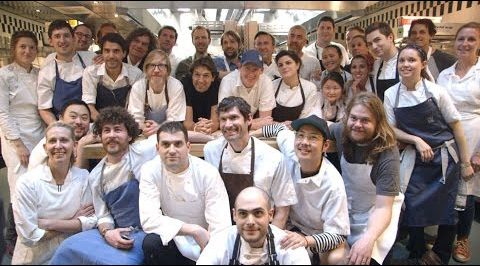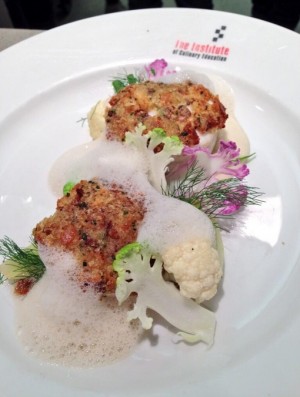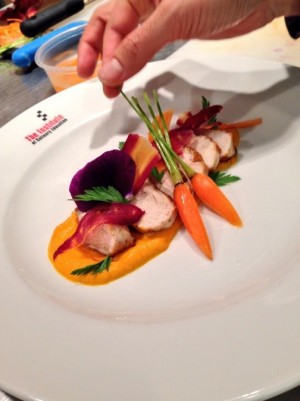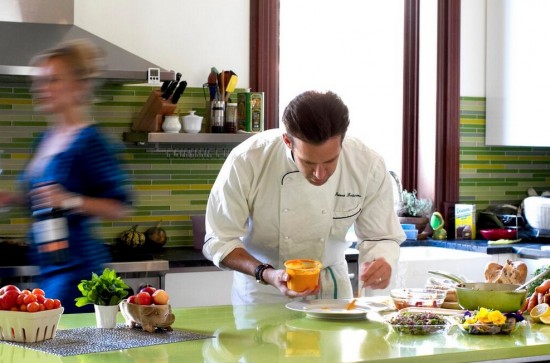Recently, a little-known group composed of the world’s most famous chefs gathered to surprise and celebrate one of their own: Chef Wylie Dufresne. The group, Gelinaz, descended on New York’s Lower East Side to toast the 10th anniversary of Dufresne's restaurant wd~50, an American temple to avant garde cuisine.

While the modernist cuisine might not be the first thing that pops into a person's mind when they think Wylie Dufresne, his food certainly falls into that category. This isn't surprising. Ask a chef tagged with the "modernist" moniker, and he or she will likely say that they never thought of their own cuisine as such. The label is typically fixed upon a chef by others in the culinary community—often as part of an ongoing debate about the positives and negatives of modern cooking techniques. So what is modern cuisine? In short, it's a buzzword—the latest term used to describe an innovative and avant garde style of cooking. First popularized by Ferran Adria (the "foam guy") at his restaurant El Bulli, the modernist cuisine has since become known the world over. Previous to Adria, modern cooking techniques were housed under the umbrella of molecular gastronomy: a scientific discipline that studies the chemistry of food. Great minds such as Nicholas Kurti, Herve This and Harold McGee made tremendous strides in this field, ultimately inspiring chefs like Adria, Heston Blumenthal, and Grant Achatz to incorporate scientific methods into their cooking. Thus, the modernist cuisine was born.

The problem with "modern cuisine" is the same that plagues all artistic fields—it is poorly replicated by people that don’t have a firm grasp of the necessary techniques. (For a comparable example, do a Google image search for "bad abstract art"). Beyond the foam, sous-vide and reverse spherification, modernist cooking is really about examining ingredients and asking, "What makes a carrot good?" and "How I make the good part of a carrot better?" Technology has enabled us to find the precise time/temperature ratio that produces a carrot more tender, sweet and delicious. Now, does that carrot taste better when it is in the form a delicate sphere? Probably not. But is it pretty cool looking? Heck yeah!

This is where that slippery slope begins. It took me many years as a chef to learn restraint. To understand that "because I can" is not a good reason to put something on a plate. In the 1970s, we were faced with a comparable culinary movement: nouvelle cuisine. As this lighter perspective on French cooking swept the globe, it led us to some strange and debatably appetizing places. (Imagine raspberry coulis, pushed into a squeeze bottle, to ultimately dot a plate of lightly cooked veal or some other horrific combination.) These things happened because people read an article about Michel Guerard or Fernand Point, but didn’t take the time to understand the heart of what these chefs were creating. Yet no matter its bizarre derivatives, nouvelle cuisine did inspire chefs to question and reimagine the way they approached their own cooking.

Today, while it could be argued that the stereotypes of the modernist cuisine—spheres, foams and other abstractions of ingredients—are considered passé, wesee restaurant menus detailing fermented this and housemade that. This trend of DIY, chef-crafted ingredients is a direct result of the scientific modernist movement. Over the past 10 years, kitchens became laboratories. In those labs, ingredients were broken down into their basic components so they could be better understood. Curious chefs discovered new ways to manipulate products, presenting them in new forms on your plate. And while the end product of these "labs" may have shifted from housemade cantaloupe caviar to artisanal pork katsuobushi, let us not forget that the path is essential.
Click here to learn more about Chef James and his work on the very modern Cognitive Cooking project with IBM.




